View in other NatureServe Network Field Guides
NatureServe
Montana
Utah
Wyoming
Idaho
Wisconsin
British Columbia
South Carolina
Yukon
California
New York
Little Copper - Lycaena hypophlaeas
Other Names:
American Copper,
Lycaena phlaeas
General Description
[From Ferris and Brown 1981; Scott 1986; Opler and Wright 1999; Glassberg 2001; Pyle 2002] Forewing 1.3-1.5 cm. Uppersurface of forewing iridescent red-orange with prominent black-brown spots, margin gray, hindwing gray with submarginal zigzag orange-red band lined inwardly with small blue spots; undersurface of forewing paler orange with large black spots in pale halos, hindwing gray with small black spots and zigzag red-orange submarginal line.
Phenology
Several flights in the east, June to September northward, mid-April to mid-October southward; one flight in west (July and August) and far north (July)(Scott 1986). July to early September (Glassberg 2001). Mid-August to early September in Oregon (Pyle 2002; Warren 2005), late July to mid-August in British Columbia (Guppy and Shepard 2001).
Diagnostic Characteristics
Best determined by a combination of the uppersurface of forewing iridescent red-orange with prominent black-brown spots, margin gray, hindwing gray with submarginal zigzag orange-red band, undersurface of hindwing gray with small black spots and zigzag red-orange submarginal line.
Species Range
Montana Range
Range Descriptions
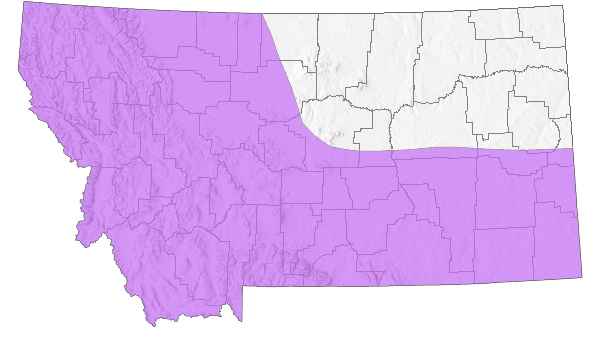
 Native
Native
Range Comments
Holarctic. In North America, possibly introduced across southern Canada and eastern US from western Great Plains to Atlantic Coast, south to northern Arkansas, Alabama, Georgia; native populations across Arctic from Alaska to Greenland, south in Rocky Mountains to Idaho, western Montana, western Wyoming, discontinuous to northeast and southwest Utah; also in central California and northeastern Oregon (Scott 1986; Opler and Wright 1999; Glassberg 2001; Pyle 2002); above 3048 m elevation in Wyoming and above 2743 m elevation in Idaho (Ferris 1974), 2743 m to at least 4000 m elevation in California (Ferris 1974, Ballmer and Pratt 1989), 2286 m to 2896 m elevation in Oregon (Pyle 2002; Warren 2005), 1219 m to 2500 m elevation in Alberta and British Columbia (Ferris 1974; Kohler 2007). In Montana, reported from nine counties in native range and one historical report from Custer County in introduced range (Kohler 1980, 2007; Stanford and Opler 1993), to 3322 m elevation in the Beartooth Mountains (Ferris 1974), 1920 m to 2107 m elevation in the Sweet Grass Hills (Kohler 2007). Locally rare (Glassberg 2001).
Observations in Montana Natural Heritage Program Database
Number of Observations: 20
(Click on the following maps and charts to see full sized version)
Map Help and Descriptions
Relative Density
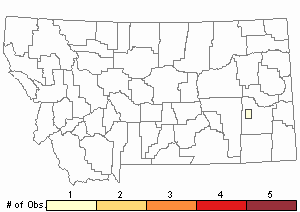
Recency

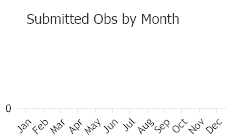
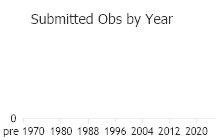
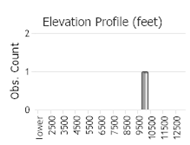 (Observations spanning multiple months or years are excluded from time charts)
(Observations spanning multiple months or years are excluded from time charts)
Migration
Non-migratory.
Habitat
For introduced populations in the east: weedy fields, hayfields, roadsides, disturbed sites; for native populations in the west and north: subalpine montane meadows, alpine fellfield above treeline, arctic tundra north of treeline (Opler and Wright 1999; Glassberg 2001; Pyle 2002). In Montana, reported from near and above treeline in alpine terrain of Greater Yellowstone Ecosystem (Ferris 1974), in Glacier National Park, Montana reported from montane mesic meadows and riparian habitats (Debinski 1993), in the Sweet Grass Hills reported from lush subalpine meadows (Kohler 2007).
Food Habits
Larval food plants include Oxyria digyna and at least three species of Rumex (Shields and Montgomery 1966; Ferris 1974; Ferris and Brown 1981; Scott 1986, 1992; Ballmer and Pratt 1989). Adults feed on flower nectar, in the west including Erigeron, Mertensia, and Solidago (Kohler 2007; Scott 2014), in the east including Boltonia, Solidago, and Zizia (Tooker et al. 2002).
Reproductive Characteristics
Limited information for North American subspecies. Females lay eggs singly on host plant leaves or stems (Scott 1986). Duration from egg-laying to egg-hatch not reported. Development from egg-hatch to pupation for California subspecies (L. p. hypophlaeas) 13-59 days (mean = 23 days for 4-instar form, 27 days for 5-instar form), adults eclose (emerge from pupae) in 7-9 days. Larvae feed on host plant leaves, overwinter (diapause) as L2-L3 (L4?) instar larvae (Scott 1979; Ballmer and Pratt 1989). Males perch, sometimes patrol, throughout the day low to ground on plants and in rocky nooks, to await or locate females (Scott 1986).
Stewardship Responsibility
References
- Literature Cited AboveLegend:
 View Online Publication
View Online Publication Ballmer, G.R. and G.F. Pratt. 1989. Instar number and larval development in Lycaena phlaeas hypophlaeas (Boisduval)(Lycaenidae). Journal of the Lepidopterists' Society 43: 59-65.
Ballmer, G.R. and G.F. Pratt. 1989. Instar number and larval development in Lycaena phlaeas hypophlaeas (Boisduval)(Lycaenidae). Journal of the Lepidopterists' Society 43: 59-65. Debinski, D. 1993. Butterflies of Glacier National Park, Montana. Occasional Papers of the Museum of Natural History, the University of Kansas, Lawrence, Kansas. No. 159: 1-13.
Debinski, D. 1993. Butterflies of Glacier National Park, Montana. Occasional Papers of the Museum of Natural History, the University of Kansas, Lawrence, Kansas. No. 159: 1-13. Ferris, C.D. 1974. Variation of Erebia callias (Satyridae) in the United States. Journal of the Lepidopterists' Society 28(3): 230-236.
Ferris, C.D. 1974. Variation of Erebia callias (Satyridae) in the United States. Journal of the Lepidopterists' Society 28(3): 230-236. Ferris, C.D. and F.M. Brown (eds). 1981. Butterflies of the Rocky Mountains. Univ. of Oklahoma Press. Norman. 442 pp.
Ferris, C.D. and F.M. Brown (eds). 1981. Butterflies of the Rocky Mountains. Univ. of Oklahoma Press. Norman. 442 pp. Glassberg, J. 2001. Butterflies through Binoculars: A Field Guide to the Butterflies of Western North America. Oxford University Press.
Glassberg, J. 2001. Butterflies through Binoculars: A Field Guide to the Butterflies of Western North America. Oxford University Press. Guppy, C.S. and J.H. Shepard. 2001. Butterflies of British Columbia: including western Alberta, southern Yukon, the Alaska Panhandle, Washington, northern Oregon, northern Idaho, northwestern Montana. UBC Press (Vancouver, BC) and Royal British Columbia Museum (Victoria, BC). 414 pp.
Guppy, C.S. and J.H. Shepard. 2001. Butterflies of British Columbia: including western Alberta, southern Yukon, the Alaska Panhandle, Washington, northern Oregon, northern Idaho, northwestern Montana. UBC Press (Vancouver, BC) and Royal British Columbia Museum (Victoria, BC). 414 pp. Kohler, S. 1980. Checklist of Montana Butterflies (Rhopalocera). Journal of the Lepidopterists' Society 34(1): 1-19.
Kohler, S. 1980. Checklist of Montana Butterflies (Rhopalocera). Journal of the Lepidopterists' Society 34(1): 1-19. Kohler, S. 2007. A description of a new subspecies of Lycaena phlaeas (Lycaenidae: Lycaeninae) from Montana, United States, with a comparative study of Old and New World populations. The Taxonomic Report of the International Lepidoptera Survey 7: 1-19.
Kohler, S. 2007. A description of a new subspecies of Lycaena phlaeas (Lycaenidae: Lycaeninae) from Montana, United States, with a comparative study of Old and New World populations. The Taxonomic Report of the International Lepidoptera Survey 7: 1-19. Opler, P.A. and A.B. Wright. 1999. A field guide to western butterflies. Second edition. Peterson Field Guides. Houghton Mifflin Company, Boston, Massachusetts. 540 pp.
Opler, P.A. and A.B. Wright. 1999. A field guide to western butterflies. Second edition. Peterson Field Guides. Houghton Mifflin Company, Boston, Massachusetts. 540 pp. Pyle, R.M. 2002. The butterflies of Cascadia: a field guide to all the species of Washington, Oregon, and surrounding territories. Seattle Audubon Society, Seattle, Washington. 420 pp.
Pyle, R.M. 2002. The butterflies of Cascadia: a field guide to all the species of Washington, Oregon, and surrounding territories. Seattle Audubon Society, Seattle, Washington. 420 pp. Scott, J.A. 1979. Hibernal diapause of North American Papilionoidea and Hesperioidea. Journal of Research on the Lepidoptera 18(3): 171-200.
Scott, J.A. 1979. Hibernal diapause of North American Papilionoidea and Hesperioidea. Journal of Research on the Lepidoptera 18(3): 171-200. Scott, J.A. 1986. The butterflies of North America: a natural history and field guide. Stanford University Press, Stanford, California.
Scott, J.A. 1986. The butterflies of North America: a natural history and field guide. Stanford University Press, Stanford, California. Scott, J.A. 1992. Hostplant records for butterflies and skippers (mostly from Colorado) 1959-1992, with new life histories and notes on oviposition, immatures, and ecology. Papilio new series #6. 185 p.
Scott, J.A. 1992. Hostplant records for butterflies and skippers (mostly from Colorado) 1959-1992, with new life histories and notes on oviposition, immatures, and ecology. Papilio new series #6. 185 p. Scott, J.A. 2014. Lepidoptera of North America 13. Flower visitation by Colorado butterflies (40,615 records) with a review of the literature on pollination of Colorado plants and butterfly attraction (Lepidoptera: Hersperioidea and Papilionoidea). Contributions of the C.P. Gillette Museum of Arthopod Diversity. Fort Collins, CO: Colorado State University. 190 p.
Scott, J.A. 2014. Lepidoptera of North America 13. Flower visitation by Colorado butterflies (40,615 records) with a review of the literature on pollination of Colorado plants and butterfly attraction (Lepidoptera: Hersperioidea and Papilionoidea). Contributions of the C.P. Gillette Museum of Arthopod Diversity. Fort Collins, CO: Colorado State University. 190 p. Shields, O. and J.C. Montgomery. 1966. The distribution and bionomics of arctic-alpine Lycaena phlaeas subspecies in North America. Journal of Research on the Lepidoptera 5(4): 231-242.
Shields, O. and J.C. Montgomery. 1966. The distribution and bionomics of arctic-alpine Lycaena phlaeas subspecies in North America. Journal of Research on the Lepidoptera 5(4): 231-242. Stanford, R.E. and P.A. Opler. 1993. Atlas of western USA butterflies: including adjacent parts of Canada and Mexico. Unpubl. Report. Denver and Fort Collins, Colorado 275 pp.
Stanford, R.E. and P.A. Opler. 1993. Atlas of western USA butterflies: including adjacent parts of Canada and Mexico. Unpubl. Report. Denver and Fort Collins, Colorado 275 pp. Tooker, J.F., P.F. Reagel, and L.M. Hanks. 2002. Nectar sources of day-flying lepidoptera of central Illinois. Annals of the Entomological Society of America 95(1): 84-96.
Tooker, J.F., P.F. Reagel, and L.M. Hanks. 2002. Nectar sources of day-flying lepidoptera of central Illinois. Annals of the Entomological Society of America 95(1): 84-96. Warren, A.D. 2005. Lepidoptera of North America 6: Butterflies of Oregon, their taxonomy, distribution, and biology. Contributions of the C. P. Gillette Museum of Arthropod Diversity, Colorado State University. Fort Collins, Colorado. 406 pp.
Warren, A.D. 2005. Lepidoptera of North America 6: Butterflies of Oregon, their taxonomy, distribution, and biology. Contributions of the C. P. Gillette Museum of Arthropod Diversity, Colorado State University. Fort Collins, Colorado. 406 pp.
- Additional ReferencesLegend:
 View Online Publication
View Online Publication
Do you know of a citation we're missing? Allen, T.J., J.P. Brock, and J. Glassberg. 2005. Caterpillars in the field and garden: a field guide to the butterfly caterpillars of North America. Oxford University Press.
Allen, T.J., J.P. Brock, and J. Glassberg. 2005. Caterpillars in the field and garden: a field guide to the butterfly caterpillars of North America. Oxford University Press. Brock, J.P. and K. Kaufman. 2003. Kaufman Field Guide to Butterflies of North America. Houghton Mifflin Company, New York, NY 284 pp.
Brock, J.P. and K. Kaufman. 2003. Kaufman Field Guide to Butterflies of North America. Houghton Mifflin Company, New York, NY 284 pp. Caruthers, J.C., and D. Debinski. 2006. Montane meadow butterfly species distributions in the Greater Yellowstone Ecosystem. University of Wyoming National Park Service Research Center Annual Report, 2006. Vol. 30, Art. 14. 85-96.
Caruthers, J.C., and D. Debinski. 2006. Montane meadow butterfly species distributions in the Greater Yellowstone Ecosystem. University of Wyoming National Park Service Research Center Annual Report, 2006. Vol. 30, Art. 14. 85-96. Debinski, D. M. 1991. Inventory and monitoring of biodiversity: an assessment of methods and a case study of Glacier National Park, MT. Ph.D. Dissertation. Montana State University, Bozeman. 205 p.
Debinski, D. M. 1991. Inventory and monitoring of biodiversity: an assessment of methods and a case study of Glacier National Park, MT. Ph.D. Dissertation. Montana State University, Bozeman. 205 p. Forister, M.L., E.M. Grames, C.A. Halsch, K.J. Burls, C.F. Carroll, K.L. Bell, J.P. Jahner, et al. 2023. Assessing risk for butterflies in the context of climate change, demographic uncertainty, and heterogeneous data sources. Ecological Monographs 93(3):e1584. https://doi.org/10.1002/ecm.1584
Forister, M.L., E.M. Grames, C.A. Halsch, K.J. Burls, C.F. Carroll, K.L. Bell, J.P. Jahner, et al. 2023. Assessing risk for butterflies in the context of climate change, demographic uncertainty, and heterogeneous data sources. Ecological Monographs 93(3):e1584. https://doi.org/10.1002/ecm.1584 Layberry, R.A., P.W. Hall, and J.D. LaFontaine. 1998. The Butterflies of Canada. University of Toronto Press. 280 pp. + color plates.
Layberry, R.A., P.W. Hall, and J.D. LaFontaine. 1998. The Butterflies of Canada. University of Toronto Press. 280 pp. + color plates.
- Web Search Engines for Articles on "Little Copper"
- Additional Sources of Information Related to "Insects"





